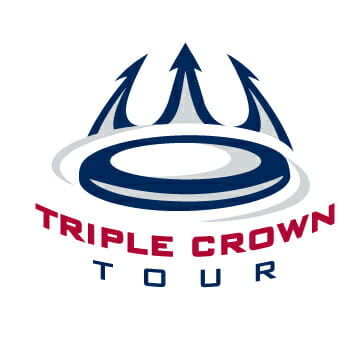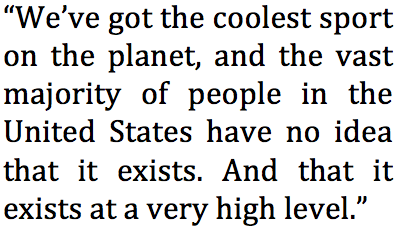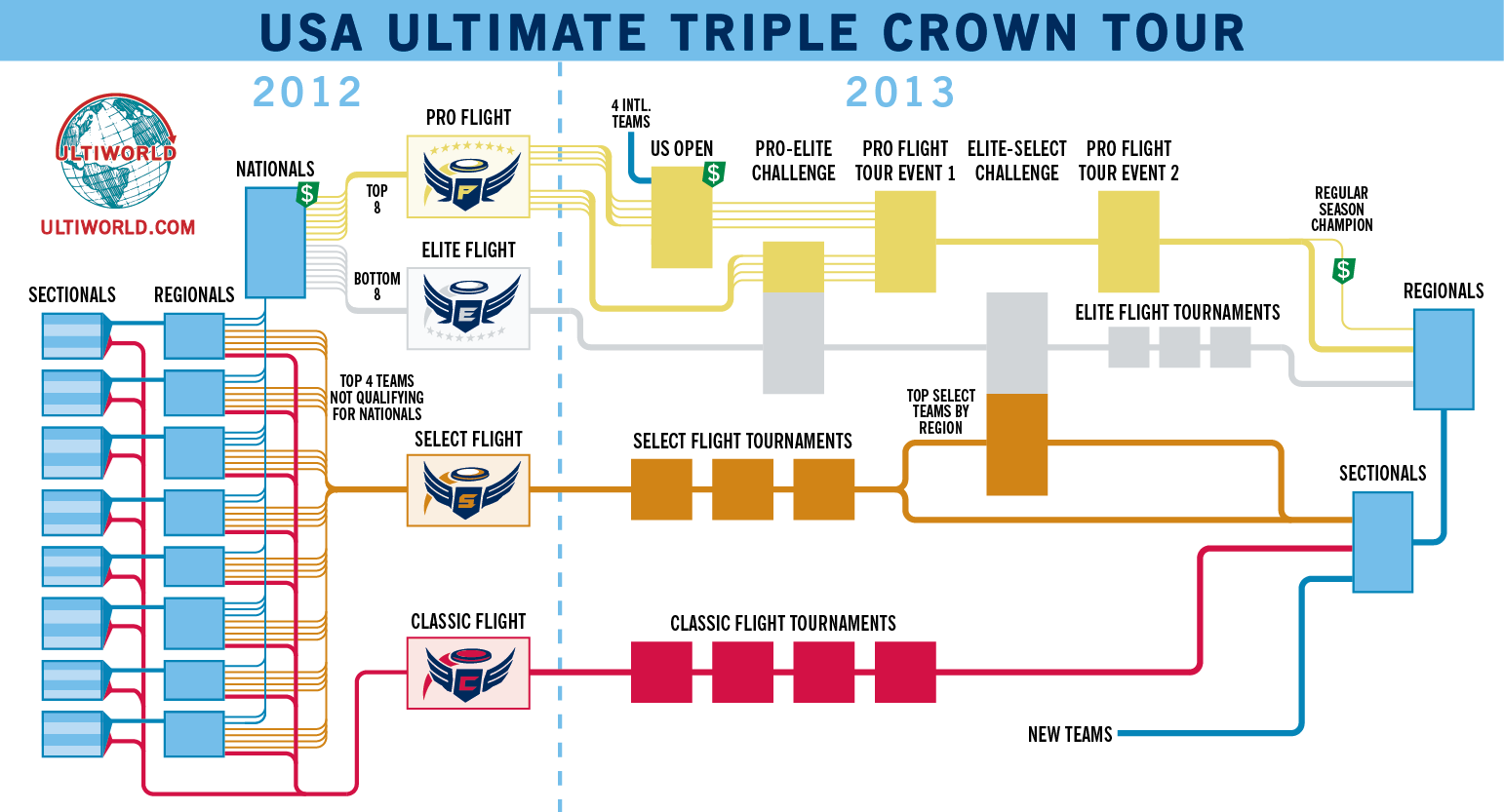October 22, 2012 by Charlie Eisenhood in Interview, News with 21 comments
 Today, USA Ultimate announced the Triple Crown Tour, a highly-anticipated restructuring of the Club Division and a major turning point in the sport that adds tiered play, new incentives, a much greater emphasis on spectators, and a more structured regular season to all divisions.
Today, USA Ultimate announced the Triple Crown Tour, a highly-anticipated restructuring of the Club Division and a major turning point in the sport that adds tiered play, new incentives, a much greater emphasis on spectators, and a more structured regular season to all divisions.
The changes, two and a half years in the making, are designed to “provide more meaningful and accessible playing opportunities for teams, stimulate participation and growth, and showcase the sport of Ultimate at its best.” The ways in which those changes are being implemented are complex, so we will explore each in turn.
WHAT IS THE TRIPLE CROWN TOUR?
To understand the Triple Crown Tour, first you need to understand how teams will be selected into the various tiers of play for the season, called ‘flights.’ Depending upon your performance in the Club Series — Sectionals, Regionals, and Nationals — you are placed into one of four flights: Pro (top eight at Nationals), Elite (bottom eight at Nationals), Select (top four teams in each region that did not qualify for Nationals), or Classic (everyone else).
Each flight has its own regular season structure. Each year, the top four teams in the Pro Flight — comprised of the Nationals semifinalists — will compete to win the Triple Crown, achieved by winning the US Open, the regular season (based on a points system), and the National Championship.
Pro teams will compete with just each other in two tour events that will help determine the regular season champion. But some of the Pro teams will also compete with the Elite teams in a “challenge tournament.” There is a similar crossover event for the Elite and Select flights. All flights will also have tournaments for their own teams.
Here’s a chart to help make sense of all this (click to expand):
The above cycle repeats each year. As you can see, if you make it to Nationals (and, therefore, into the Pro or Elite flight), you no longer have to compete at Sectionals. Every team will have the opportunity — just as they do now — to advance through the Series and win the National Championship, potentially moving up in flights over time.
Bids to Nationals will continue to be determined — as they were this year — by a strength bid system. Every region will be represented with an automatic bid, with the other bids given out to the region with the “next best” eight teams, based on the end of the season USA Ultimate rankings.
The money symbols in the flowchart refer to new prizes being offered for performance. A win at the US Open or Nationals gets you a cash prize, as does winning the regular season. Winning all three — a Triple Crown victory — means another cash bonus.
Currently, the prizes aren’t huge, but USA Ultimate expects them to grow over time as more sponsors get involved.
“One thing that we really want to be careful of is that we don’t want to use member dues to feed the prize money pool,” said Tom Crawford, CEO of USA Ultimate. “That just doesn’t feel right to us. So we’re going to create prize money pools out of incremental revenue, and revenue that we create as a result of this new structure.”
Crawford added, “The better success we have promotable, televisable, sponsorable events, the greater that pool of prize money will grow…Initially it’s not going to be a huge chunk because we’re still busy trying to sell this.”
WHY THIS STRUCTURE?
The new ‘flights’ format is a substantial change for the Club Division. Although there have long been “elite” tournaments where the top teams head to face off, this system is far more structured and requires teams in the top flights to attend certain tournaments. Why? Will Deaver, USA Ultimate’s Managing Director of Competition and Athlete Programs, explained that after “years gathering feedback from the community,” teams wanted to make the regular season more meaningful and play in different tiers, which ensures that “people who are playing against each other are going into the game with the same expectation,” while maintaining the bid allocation system that makes the regular season count.
“We looked at a lot of different sports models,” he added. “One that resonated a fair amount was the English soccer system where you have a lot of different levels and every community has a team that they’re really excited about.”
Balancing those desires with a need to keep tournaments affordable was an important factor in the Triple Crown Tour design. “Accessibility was a big thing, making sure that teams and players can get to the venues and the playing opportunities that are out there,” said Deaver. “Because it costs money to play this sport…Down the line, we want to be able to have a structure like this to help infuse money into the sport that isn’t already there and hopefully bring some of those participant costs down.”
 Creating a Pro Flight was also a strategic move. USA Ultimate’s number one goal in their new six-year strategic plan is to “increase the visibility of Ultimate.” They believe this is the way to do that.
Creating a Pro Flight was also a strategic move. USA Ultimate’s number one goal in their new six-year strategic plan is to “increase the visibility of Ultimate.” They believe this is the way to do that.
Primarily, Deaver explained, this model allows USA Ultimate to “showcase the sport at its best, [using] the top level of play in the world to promote the sport and push that evolution into more public visibility, access to media, [and] access to sponsors.”
“Our goal is to turn [the Pro Flight] events into very, very fan friendly events where they come in and have an experience,” said Crawford. “They don’t just come in and watch some ultimate.”
USA Ultimate hopes the new focus on spectators will bring in major media coverage. “We have very high level discussions going with just about every serious sports television network that you can talk to,” said Crawford. “And we are talking to them about this: that there is a new competitive structure that the top teams and top athletes will be competing in that fans will be able to follow…And they’re getting interested as a result of the new structure.”
They hope to broadcast the US Open and the Club Championships, while lining up coverage of the Triple Crown Tour race.
USA Ultimate hopes the increased exposure will solve one of the big problems for Ultimate. As Crawford put it, “We’ve got the coolest sport on the planet, and the vast majority of people in the United States have no idea that it exists. And that it exists at a very high level.”
TOURNAMENTS
One of USAU’s survey findings was that both players and fans really like the tournament format that currently exists. Normal sanctioned tournaments that can be attended by teams in any flight will still be a part of the regular season. But the newly-created — and mandatory — tournaments for the top flights will allow for a marketable event.
Andy Lee, USAU’s Marketing and Communications Director, wrote, “The tournament format of the Triple Crown Tour gives existing and future fans the opportunity to watch world-class Ultimate at fan-friendly venues around the country on a consistent basis. Compelling storylines and statistical analysis centered around athletes, teams and events will help create geographic loyalty and a regular following of Ultimate’s most notable stars and personalities.”
The top flight tournaments will be bid out, explained Deaver, to “host cities that are excited about running the events, that have great venues, that have great communities, and that are good locations to be able to showcase the teams and these competitions to an audience.”
USAU is discussing some of these tournaments with current event organizers. It seems possible that tournaments like the Emerald City Classic or Labor Day Championships could become Pro Tour events.
Charging admission fees for spectators is in the plans, though the pricing could vary widely depending on the services offered.
WILL THE PROFESSIONAL LEAGUES COMPETE?
Since USAU is thinking about to beginning to charge spectators, it is only natural to turn to how this new Club structure could affect the new professional Ultimate leagues, the American Ultimate Disc League — heading into its second season — and Major League Ultimate, a new endeavor said to be hosting its first season in 2013.
Competition for players (and even teams) could begin to happen, not just between the two pro leagues but between them and USA Ultimate.
Crawford didn’t seem worried. “We’ve been working on this for two and a half years,” he said. “This preceded all of that stuff. Major League Ultimate, we haven’t got the slightest idea what that is. We’ve heard that there’s something, but what is it? As of now it doesn’t exist.
“And the AUDL? Thank God we weren’t affiliated or associated with that. Or we’d be in the middle of a bunch of lawsuits right now.”
He continued to stress that players would be happy with the new system because everything was developed through surveys and focus groups with them. “We think we have a phenomenal plan…,” Crawford said. “It’s going to appeal to [athletes and teams] because this was based on two years of research and talking to them.”
CHANGE
How will this major overhaul be received by players? A great deal of change so suddenly frequently invites mixed opinions.
“It was one of those difficult things that we found with the community feedback,” said Deaver. “On the one hand, a lot of folks say they want structure and they want a regular season…On the other hand, there’s a little bit of resistance of being told where to go and what to do. And I think that’s natural… But I think it’s more the perception of that then the reality of doing something different.”
Crawford added, “We took our time with this because this does represent a change…But it’s a change that I think everybody is on board for. And by taking our time – which we do sometimes get criticized for – we actually think what it’s leading to is a very high quality plan.
“…This is something new that still celebrates the history and culture of ultimate and is very accessible to everybody…But we’re also able to accomplish a couple of really important goals in our strategic plan…We’re going to put ultimate on the national sports stage in a bigger way than it’s ever been done before. If we get this just right, five years from now who knows what could be created.”
